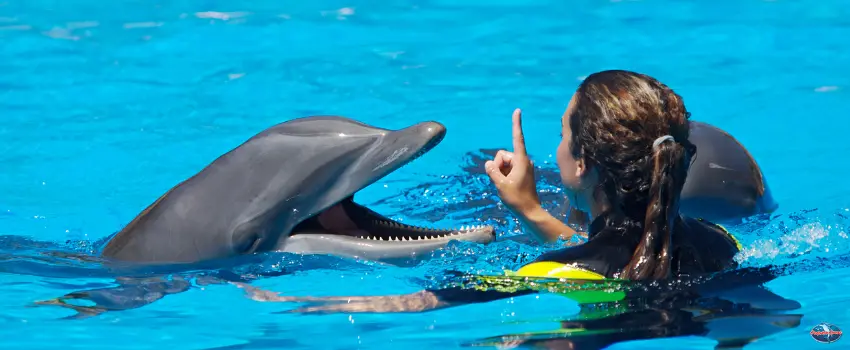Maintaining a healthy relationship with dolphins in the ocean and rivers of the world is our moral imperative. Any time humans board a vessel to explore the oceans, we are guests; this is not our natural habitat. For dolphins in the wild, this is their home. To continue enjoying dolphin sightseeing — as well as the manatee, whale, and otherwise — we must do what we can to protect their environment.
According to the Dolphin Research Center in Grassy Key, Florida, there are currently six species of dolphin considered endangered. An endangered species is such that when the population drops to a low level, that puts them at risk for extinction. The primary factors that threaten a species are the loss of genetic variation and habitat loss. For dolphins, habitat loss is the primary factor threatening the species.
A Current Assessment

How many dolphins are left in the world is a complicated question and is dependent on the species. The most common dolphin species seen in Tampa Bay is the bottlenose, of which there are roughly 600,000 in the world. Of all dolphin species combined, there are roughly eight million. Impressive as it may seem, there are certain species of dolphin that are close to extinction while others are under threat.
The International Union for Conservation of Nature’s Red List of endangered species, first published in 1964, is a compendium of animals at risk of extinction. This, coupled with the United State’s Endangered Species Act, note that out of 41 dolphin species, nine are endangered.
Along the Florida coast, John’s Pass is famous for drawing tourists who wish to see bottlenose dolphins in their natural habitat. Even here, where dolphin sightings are common, the numbers are shrinking due in part to coastal construction. Habitat loss is the primary factor that drives dolphins away in search of new, safer environments. Though the bottlenose dolphin itself is not considered endangered, coastal construction remains a factor in the decreasing population in the area.
Dolphins considered endangered are river dolphins. These, such as the Amazon River dolphin (boto) and South Asian river dolphins, are at risk of extinction due to the same reason bottlenose dolphins leave for safer, quieter waters: habitat destruction. Marine dolphins are sensitive to any change in their environment, much in the same way, a human would be if a wrecking ball came through their living room.
Current and Future Threats

Real dolphins seem ubiquitous in the waters of the world. After all, they’re the official mascot of beachfront tourist destinations globally. If we are to continue relying on them for tourist dollars, we must act to preserve their species well into the future.
Dolphins in the wild require several things to thrive. Firstly, a reliable food source. Dolphins consume fish, squid, and small crustaceans as the apex predator in many of the world’s waters. When considering the safety and future of dolphins, we must also consider the preservation of their food sources.
Overfishing is not only a threat to dolphins but to the ocean itself. Humans have developed ways to collect large amounts of fish in a very short period of time, which usually involves dredging. For every pound of shrimp caught, for instance, up to thirty pounds of ‘bycatch’ is caught as well. This can include all manner of species, including turtles and dolphins. The capture of small fish, such as sardines, depletes the population that dolphins in the ocean rely upon.
Climate change is a reality that marine life experiences firsthand. Dolphins are affected by rising sea levels as severe weather can wreak havoc on the coastal ecosystem. Rising water temperatures mean dolphins’ food migrates to cooler waters where they cannot follow. This, coupled with marine pollution, is making life difficult for all marine species.
Finally, noise pollution is a real factor for dolphins. Dolphins in the ocean use their honed senses to locate food, identify threats, and communicate with each other. Digging trenches and oil field activities make hearing each other and navigation a daunting task.
These threats, and much more, are factors currently affecting all species of dolphins, no matter which part of the world they call home.
A Bright Future?

It’s hard to imagine a world without real dolphins. Seeing dolphins in the wild is an experience many find unforgettable. It’s possible we could lose this privilege if we don’t take action to prevent disaster. There are people and organizations fighting to protect the ocean and its species.
Eating sustainable food is a good way to make a difference at the dinner table. Seafood Watch maintains a list of species that are safe to eat. Consuming these species has little impact on the health of the environment.
Ecotourism is the best way to witness firsthand what is at stake should we do nothing to fight the dangers inherent in human activity worldwide. There is no better way to develop an appreciation for the environment than to experience it firsthand. Making sure to choose an environmentally-conscious tourism company is important as well.
Voting is another method by which to protect the environment. Asking important questions of candidates and representatives, such as their position on climate change and environmental protection, can mean the difference between having an ally in Congress and a hindrance.
Finally, doing your part is important as well. Small changes can make a big difference. Whether that be to make an effort to conserve water, drive less, or speak out against polluters.
With any hope, Googling “Are dolphins extinct?” may go extinct itself.
Responsible Tourism with Sunshine Scenic Tours
The Dolphin Quest, a Johns Pass dolphin cruise, prides itself on educating tourists about the fragile ecosystem we inhabit and ways in which we can protect it. Expert guides are aboard every cruise to inform and answer questions while viewing dolphins from a safe distance.
Tours depart daily from John’s Pass at Madeira Beach, St. Petersburg. Call us today and see how truly breathtaking dolphins are.











